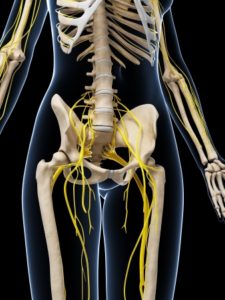
Sciatic pain is very common and a lot of us will experience it at some point, but what is it exactly? The word “sciatic” refers to a specific nerve in the leg. The sciatic nerve is, in fact, the largest nerve in the body. It travels down the back of the thigh to the back of the knee where it splits into two separate nerves that travel down the back of the calf and into the foot.
Generally when someone is diagnosed with sciatic pain, or “sciatica” as it is sometimes called, the pain begins in the buttock and radiates down the back of the leg, sometimes as far as the toes. This may be accompanied by lower back pain as well, but in my experience it almost always starts in the buttock and not the lower back.
What causes this pain in the first place? Well it is most likely compression on the nerve, which is interpreted by the brain as unpleasant and potentially dangerous, and so often produces pain as a warning signal for us. In order to understand where the probable cause of the problem lies, we need to know a bit more about the nerve itself.
The beginning of the sciatic nerve forms from nerve fibres from the spinal cord, which exit the spine at several different levels (i.e. between several different back bones called vertebrae) and then come together at around the level of the upper buttock. Picture a cheese string that has been partially shredded on one end. Once the shredded ends of the cheese string come together, the sciatic nerve begins.

The cheese string is in the middle of the photo.
The issue is that the lower back is often blamed as the cause of sciatic pain. If you Google causes of sciatic pain you will mostly find things like herniated discs in the lower back or lumbar spinal stenosis, which is a narrowing of the opening through which the strands of the cheese string pass as they leave the spinal cord. This mystifies me as problems in the lower back could only ever cause potential issues with a few of the strands of the shredded cheese string, and not the whole sciatic nerve trunk where the strands all come together. For this reason, treatment aimed solely at the lower back, as it often is, generally does not have any lasting benefits.
Where then does the real problem lie? The most likely place for the sciatic nerve trunk to be compressed is in the buttock. There is one place in particular where it is very vulnerable to compression. This is where it passes beneath a small band-like muscle called piriformis, which crosses the sciatic nerve at a right angle. If piriformis is overactive and thus becomes very firm, it can compress the sciatic nerve as it passes beneath. The real question is why would piriformis do such a thing? Surely it must know this is going to cause problems!
The most common reason for a muscle to become overactive is because it is trying to compensate for another muscle that is not doing its share. Seems logical, doesn’t it? In this case, the underachiever is the gluteal muscles which are the muscles that form the roundness of the buttock. These are big powerful muscles that are meant to straighten the hip and stabilize the pelvis when we move. These are important jobs requiring significant force, so if the gluteals are not active, then someone else has to carry the load. Because of where it lies, piriformis is the most likely to step into the void. The problem is, poor piriformis is a small and not so powerful muscle so it will have to work like the dickens to try to compensate. As a result the muscle becomes extremely tight and hard. When this happens it can potentially compress the sciatic nerve, and zing the pain goes down the back of the leg.
I have never seen anyone who had sciatic pain whose gluteal muscles were functioning properly. There are other areas along the route of the sciatic nerve where issues can occur, but the buttock area must be addressed if treatment is to produce long-term improvement. If you have persistent sciatic pain and have only ever had treatment aimed at your back, now you likely know why it was not completely successful. An approach looking at the whole body is necessary to find where the true problem lies.